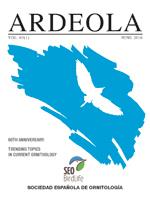With the aim to identify priorities in conservation-oriented research, this paper reviews the level of scientific attention given to steppe birds in Spain during the last 50 years. We surveyed scientific literature using Thomson Reuters Web of Science and the journal Ardeola, using the English names of 28 species of steppe birds and the word “Spain” as search terms. Every species was assigned a Scientific Attention Index (SAI), based on the number of articles published on each of them. In addition, a vulnerability measure (Vulnerability Score; VS) was calculated for each species on the basis of the trend estimate provided by the Sacre or Noctua monitoring programmes, or according to expert criteria. The sample gathered (432 articles) was a significant and thus representative proportion of WOS and Ardeola contents on the species considered. The most studied species was the red-legged partridge Alectoris rufa, with 83 papers (20.15%); while the least studied was the short-eared owl Asio flammeus (1 paper; 0.24%). The most studied knowledge area was Habitat Selection (92 papers; 22.17%), while the least was Niche/Climate, with nine papers (2.17%). Preferred habitat (grass steppe, shrub steppe or mixed) was not a significant factor in the level of scientific attention given to the different species. However, large-sized species (non-Passerines) were significantly more studied than small-sized ones (Passerines), indicating a research bias for the former group. Finally, no significant relationship was found between SAI and VS, which suggests that research effort has been allocated irrespective of the species' conservation status. These results highlight the scarce scientific attention given to most steppe birds in Spain in spite of their overall high vulnerability, and for most of the knowledge areas considered. On the other hand, they also show the high relative importance of research carried out in Spain, in both the Mediterranean and world contexts. This work underscores the need to focus scientific effort on certain species, especially those that currently show more regressive trends or higher levels of vulnerability, and in most areas of knowledge.
How to translate text using browser tools
1 June 2016
Prioritising Research in Steppe Bird Conservation: A Literature Survey
Manuel B. Morales,
Juan Traba

Ardeola
Vol. 63 • No. 1
June 2016
Vol. 63 • No. 1
June 2016
atención científica
España
especie bandera
estepas de matorral
estepas herbáceas
Flagship species
grass steppes





